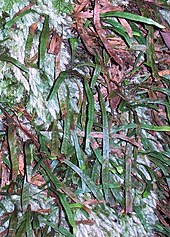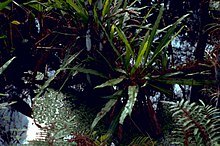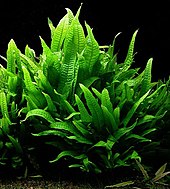Polypodiaceae
| Polypodiaceae | |
|---|---|

| |
| Pleopeltis polypodioidesfronds on an oak limb | |
| Scientific classification | |
| Kingdom: | Plantae |
| Clade: | Tracheophytes |
| Division: | Polypodiophyta |
| Class: | Polypodiopsida |
| Order: | Polypodiales |
| Suborder: | Polypodiineae |
| Family: | Polypodiaceae |
| Subfamilies and genera | |
|
See text. | |
| Synonyms | |
| |
Polypodiaceaeis afamilyofferns.In thePteridophyte Phylogeny Groupclassification of 2016 (PPG I), the family includes around 65generaand an estimated 1,650speciesand is placed in the orderPolypodiales,suborderPolypodiineae.[1]A broadercircumscriptionhas also been used, in which the family includes other families kept separate in PPG I. Nearly all species areepiphytes,but some are terrestrial.[2]
Description
[edit]Stems of Polypodiaceae range from erect to long-creeping. Thefrondsare entire, pinnatifid, or variously forked or pinnate. Thepetioleslackstipules.The scalyrhizomesare generally creeping in nature. Polypodiaceae species are found in wet climates, most commonly inrain forests.In temperate zones, most species tend to beepiphyticorepipetric.[2]
Notable examples of ferns in this family include the resurrection fern (Pleopeltis polypodioides) and the golden serpent fern (Phlebodium aureum).[2]
Taxonomy
[edit]Two distinct circumscriptions of the family are in use. ThePteridophyte Phylogeny Groupclassification of 2016 (PPG I) uses a circumscription of Polypodiaceae in which the family is placed in the suborderPolypodiineae(eupolypods I), along with eight other families. The relationship between the families is shown in the consensus cladogram below.[1]
| Polypodiineae(eupolypods I) | |
An alternative approach treats the suborder Polypodiineae as the family Polypodiaceaesensu lato,and reduces the families to subfamilies, so that the Polypodiaceaesensu strictobecomes the subfamily Polypodioideae.[3]The broader circumscription is used byPlants of the World Online,as of August 2019[update];for example, theDryopteridaceae,shown above as a separate family, is included in its Polypodiaceae.[4]The broadly defined Polypodiaceae has been described as an "unwieldy megafamily".[5]
Subfamilies
[edit]Molecular phylogeneticanalysis has led to the division of the Polypodiaceae into six subfamilies, and to the inclusion of genera that have at various times been placed in other families, including the Drynariaceae, Grammitidaceae, Gymnogrammitidaceae, Loxogrammaceae, Platyceriaceae, and Pleurisoriopsidaceae.[1][6]The followingcladogramshows a possible phylogenetic relationship between the subfamilies based on an analysis published in 2008; at the time, Grammitidoideae was not separated from Polypodioideae.[7][8]
| Polypodiaceae |
| ||||||||||||||||||||||||||||||||||||||||||||||||||||||||||||||||||||||||
The subfamilies are treated as tribes in other systems. Mabberley, in 2008, treated all of Polypodiaceae except for the Platycerioideae (PlatyceriumandPyrrosia) and the grammitid ferns, which he placed in Grammitidaceae, as the subfamily Polypodioideae, which he then divided into six tribes, four of which correspond to PPG I subfamilies (Drynarieae, Loxogrammeae, Microsoreae and Polypodieae) and others of which have been submerged (Selligueeae, now within Drynarioideae, and Lepisoreae, now within Microsoroideae).[9]Other systems also treat the subfamilies as tribes.[3]The equivalence is shown in the following table.
| PPG I[1] | Christenhusz & Chase (2014)[3] |
|---|---|
| FamilyPolypodiaceaeJ.Presl & C.Presl | Subfamily PolypodioideaeB.K.Nayar |
| SubfamilyLoxogrammoideaeH.Schneid. | Tribe LoxogrammeaeR.M.Tryon & A.F.Tryon |
| SubfamilyPlatycerioideaeB.K.Nayar | Tribe PlatycerieaeChristenh. |
| SubfamilyDrynarioideaeCrabbe, Jermy & Mickel | Tribe DrynarieaeChandra |
| SubfamilyMicrosoroideaeB.K.Nayar | Tribe MicrosoreaeV.N.Tu |
| SubfamilyPolypodioideaeSweet | Tribe PolypodieaeHook. & Lindl. ex Duby |
| SubfamilyGrammitidoideaeParris & Sundue |
Genera
[edit]In the list that follows, the taxa shown with the "(=)"prefix are considered to be synonyms for the accepted subfamily name that they follow. However, this does not necessarily imply that the subfamily contains all of the synonym's previous genera.[1][6]
| Phylogeny of Polypodiaceae[10][11] | ||||||||||||||||||||||||||||||||||||||||||||||||||||||||||||||||||||||||||||||||||||||||||||||||||||||||||||||||||||||||||||||||||||||||||||||||||||||||||||||||||||||||||||||||||||||||||||||||||||||||||||||||||||||||||||||||||||||||||||||||||||||
|
- Subfamily AdetogrammoideaeZhang & Wei
- AdetogrammaAlmeida
- SubfamilyCampyloneuroideaeZhang & Wei
- CampyloneurumC.Presl
- MicrogrammaC.Presl
- NiphidiumJ.Sm.

- SubfamilyDrynarioideaeCrabbe, Jermy & Mickel(DrynarieaeSubh.Chandra;SelligueeaeHennipman[9];AglaomorpheaeChandra;CrypsinoideaeNayar)
- Drynaria(Bory 1825) Smith[Aglaomorpha]
- PichisermollodesFraser-Jenk. & Challis.
- SelligueaBory[Arthromeris;Gymnogrammitis;Paraselliguea;Polypodiopteris]
- ×SellimerisFraser-Jenkins, Singh & Fraser-Jenkins
- SynammiaC.Presl

- SubfamilyGrammitidoideaeParris & Sundue[GrammitideaePresl;MecosoreaeKlotzsch;PleurogrammeaeFée ex Pfeiffer]
- AcrosorusCopel.
- AdenophorusGaudich.
- AlansmiaM.Kessler, Moguel, Sundue & Labiak
- ArchigrammitisParris
- AscogrammitisSundue
- CalymmodonC.Presl
- CeradeniaL.E.Bishop
- ChrysogrammitisParris
- CochlidiumKaulf.[XiphopterisKaulfuss]
- CtenopterellaParris
- DasygrammitisParris
- EnterosoraBaker[ZygophlebiaL.E.Bishop]
- GalactodeniaSundue & Labiak
- GrammitisSw.
- LellingeriaA.R.Sm. & R.C.Moran
- LeucotrichumLabiak
- LomaphlebiaJ.Sm.
- LuismaM.T.Murillo & A.R.Sm.
- MelpomeneA.R.Sm. & R.C.Moran
- MicropolypodiumHayata
- MoranopterisR.Y.Hirai & J.Prado
- MycopterisSundue
- NotogrammitisParris
- OreogrammitisCopel.[RadiogrammitisParris;Themelium(T.Moore) Parris]
- ParrisiaShalisko & Sundue
- ProsaptiaC.Presl[CtenopterisBlume ex Kunze non Brongniart ex de Saporta non Newman]
- ScleroglossumAlderw.[Nematopterisvan Alderwerelt van Rosenburgh]
- StenogrammitisLabiak
- TerpsichoreA.R.Sm.
- Tomophyllum(E.Fourn.) Parris
- XiphopterellaParris

- SubfamilyLoxogrammoideaeH.Schneid.(LoxogrammeaeR.M.Tryon & A.F.Tryon)
- Lacks sclerenchyma (supporting tissue) in plant body, except in the roots.[9]
- DictymiaJ.Sm.
- Loxogramme(Blume) C.Presl

- SubfamilyMicrosoroideaeB.K.Nayar(LepisoroideaeChing;MicrosoreaeV.N.Tu;LemmaphylleaeTu)
- BosmaniaTesto
- DendroconcheCopel.[12]
- EllipinemaZhang & Zhang
- Goniophlebium(Blume) C.Presl
- LecanopterisReinw. ex Blume
- LemmaphyllumC.Presl
- LepidomicrosoriumChing & K.H.Shing
- Lepisorus(J.Sm.) Ching
- LeptochilusKaulf.[KontumiaWu & Lôc]
- MicrosorumLink[KauliniaNayar]
- NeocheiropterisChrist.
- NeolepisorusChing
- Paragramma(Blume) T.Moore
- PhymatosorusPichi-Sermolli
- PodosorusHolttum
- ThylacopterisKunze ex J.Sm.
- TricholepidiumChing
- ZealandiaTesto

- SubfamilyPlatycerioideaeB.K.Nayar(PlatycerieaeChristenhusz)
- Fronds with stellate hairs (star-shaped, radiating from center).[9]
- HovenkampiaZhang & Zhou
- PlatyceriumDesv.
- PyrrosiaMirb.

- SubfamilyPolypodioideaeSweet(PolypodieaeHooker & Lindley ex Duby (sensuMabberley 2008))
- PeclumaM.G.Price.
- Phlebodium(R.Br.) J.Sm.
- ×PhlebosiaViane & Pompe
- PleopeltisHumb. & Bonpl. ex Willd.
- PleurosoriopsisFomin
- PolypodiumL. Perhaps
- Subfamily SerpocauloideaeZhang & Wei
- SerpocaulonA.R.Sm.
See also
[edit]References
[edit]- ^abcdePPG I (2016)."A community-derived classification for extant lycophytes and ferns".Journal of Systematics and Evolution.54(6): 563–603.doi:10.1111/jse.12229.S2CID39980610.
- ^abcPanigrahi, G. & Patnaik, S.N. (1961). "Cytology of Some Genera of Polypodiaceae in Eastern India".Nature.191(4794): 1207–1208.Bibcode:1961Natur.191.1207P.doi:10.1038/1911207a0.S2CID4177788.
- ^abcChristenhusz, Maarten J.M. & Chase, Mark W. (2014)."Trends and concepts in fern classification".Annals of Botany.113(9): 571–594.doi:10.1093/aob/mct299.PMC3936591.PMID24532607.
- ^"DryopteridaceaeHerter ".Plants of the World Online.Royal Botanic Gardens, Kew.Retrieved2019-08-02.
- ^Sundue, Michael A.; Parris, Barbara S.; Ranker, Tom A.; Smith, Alan R.; Fujimoto, Erin L.; Zamora-Crosby, Delia; Morden, Clifford W.; Chiou, Wen-Liang; Chen, Cheng-Wei; Rouhan, Germinal; Hirai, Regina Y. & Prado, Jefferson (2014). "Global phylogeny and biogeography of grammitid ferns (Polypodiaceae)".Molecular Phylogenetics and Evolution.81:195–206.doi:10.1016/j.ympev.2014.08.017.PMID25173566.S2CID21098484.
- ^abChristenhusz, Maarten; Zhang, Xian-Chun & Schneider, Harald (2011)."A linear sequence of extant families and genera of lycophytes and ferns".Phytotaxa.19:7–54.doi:10.11646/phytotaxa.19.1.2.Retrieved2013-08-11.
- ^Schuettpelz, Eric & Pryer, Kathleen M. (2008)."Fern phylogeny"(PDF).In Ranker, Tom A. & Haufler, Christopher H. (eds.).Biology and Evolution of Ferns and Lycophytes.Cambridge University Press.Retrieved2019-08-02.
- ^Chen, Chi-Chuan; Hyvönen, Jaakko; Schneider, Harald (2020)."Exploring phylogeny of the microsoroid ferns (Polypodiaceae) based on six plastid DNA markers".Molecular Phylogenetics and Evolution.143:106665.doi:10.1016/j.ympev.2019.106665.hdl:10138/321115.PMID31704235.S2CID207948290.
- ^abcdMabberley, D.J. (2008).Mabberley's plant-book: a portable dictionary of plants, their classification and uses.Cambridge University Press. p. 690.ISBN978-0-521-82071-4.
- ^Nitta, Joel H.; Schuettpelz, Eric; Ramírez-Barahona, Santiago; Iwasaki, Wataru; et al. (2022)."An Open and Continuously Updated Fern Tree of Life".Frontiers in Plant Science.13:909768.doi:10.3389/fpls.2022.909768.PMC9449725.PMID36092417.
- ^"Tree viewer: interactive visualization of FTOL".FTOL v1.3.0. 2022.Retrieved12 December2022.
- ^Testo, Weston L.; Field, Ashley R.; Sessa, Emily B. & Sundue, Michael (2019)."Phylogenetic and Morphological Analyses Support the Resurrection ofDendroconcheand the Recognition of Two New Genera in Polypodiaceae Subfamily Microsoroideae "(PDF).Systematic Botany.44(4): 737–752.doi:10.1600/036364419X15650157948607.S2CID208176686.Retrieved2020-02-11.
